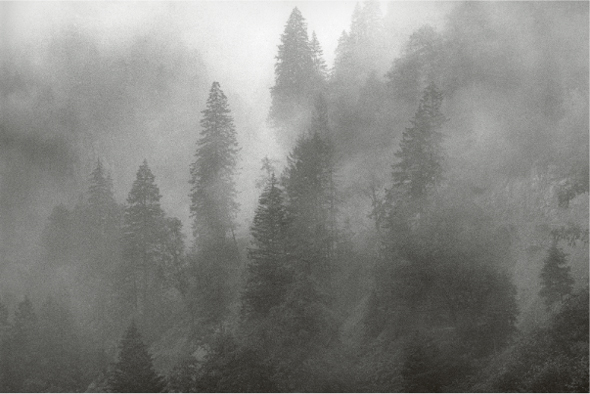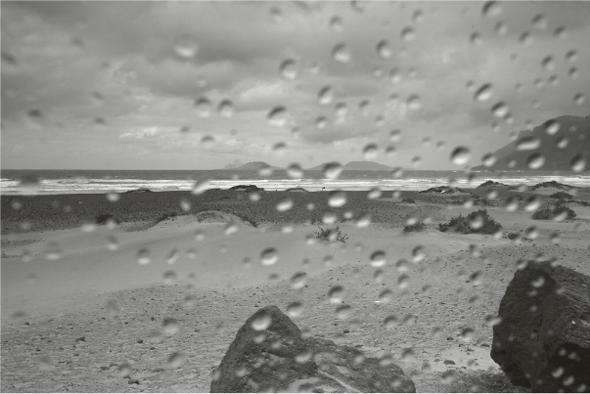10 The Poetry of Melancholy Moods
In our contemporary society, which is characterized by suppression, melancholy is often frowned upon. Yet, what would art or the world of photographic images be without the special poetry of melancholy moods?
Although in today’s fun-loving society a melancholic person is seen as a spoilsport, Leonardo da Vinci saw melancholia as a special quality that was an important prerequisite of the artistic personality. However, in former times melancholia was not linked mainly to taking everything seriously; rather, it was defined as an impulse to seek out the depth and true nature of things in a quest to turn away from life’s superficialities. If you carefully read about the lives of numerous composers, writers, or visual artists, you will notice that melancholia characterized their lives. How much would the world lack if it didn’t have Hermann Hesse’s writings, Rainer Maria Rilke’s poems, Van Gogh’s canvases, Caspar David Friedrich’s grand landscapes, Edward Hopper’s urban scenes, Ferde Grofé’s suites, or Rachmaninov’s piano concertos? From this you can discern a fundamental truth: It is the nature of many artists to pour the “unbearable lightness of being” into an art form and to fathom the deep nature of things. Why should photography, as an artistic way of representing the world, not also participate in this expression? And it is especially in photography, as you have seen, that the tendency is to produce pretty, clichéd photos. In reality, viewing a sunset is certainly a fascinating and exhilarating experience, but it’s nearly impossible to avoid creating a clichéd photo of a sunset! A photo will only be really successful if, whenever possible, it does not compare badly with reality.
A photograph of a sunset will usually compare very badly with the real thing, but photos of much more banal subjects that are intensified in a composition can sometimes express more than the real subject. How many photographic artists have succeeded to intensify banal subjects by converting them to master photographs? This is a much greater art than just photographing impressive moments such as sunrises or sunsets or grandiose images of landscapes and cities, many of which have become clichéd photos. With this in mind, a plea for including melancholic moments in photographs should be understood.
With that said, it is one of the biggest mistakes to follow the rule to leave the camera at home when it is raining or the skies are gray because the changing weather conditions can also tell stories. However, many photographers fail when attempting to shoot in the rain, which is almost impossible to capture with the camera. Only backlighting is capable of making rain clearly visible on film or sensor. In the cinema or on television, rain is usually lit with strong backlights. If you want to capture rainy conditions in photographs, try including damp windowpanes in your images. Or you can photograph at night, as Robert Hausser did in his impressive photo in which his slightly long exposure showed the rain, illuminated by a street lamp, falling on a bench and on the asphalt.
Melancholy can be expressed through changing weather conditions as well as abandoned places or objects (most of the works by Robert Hausser can attest to that). The feeling of melancholy can also be vividly reflected in the human countenance and tell the story of a person’s life. A master of melancholic poetry is the photographer Josef Sudek. He has infused all his subjects, whether landscapes, cities at night, abandoned gardens, or still lifes, with a hint of melancholy that does not depress the viewer but instead stops and grants him a moment of contemplation.
Italian Rain
Referring to rain, Mario Hene once sang, “It’s as if every drop tells a story.” His hymn to rain continues, “. . . the window panes slowly become blind . . .” Friedensreich Hundertwasser loved the rain too, and even named his houseboat Rainy Day. If you are able to feel it, rain has its own very special intrinsic poetry.
This magic is, of course, especially tangible in a room with a wonderful view in a small Ligurian village. The rainy mood in the image in figure 10–1 invites you, in your imagination, to get comfortable behind the protective window pane and enjoy the view of the ancient town on the opposite hillside.
In the lower-left third of the image, the notebook screen is fully integrated into the overall picture. The image has a classical composition that is built around certain basic elements. The horizontal slat in the window frame is aligned with the lower horizontal “golden ratio” line and the distant town lies near the upper one. The right-hand edge of the open notebook also lies close to the right-hand vertical line.
The photo was shot at f20 using a Canon 70–200 mm lens set to 93 mm. Focus was set on the village, and the raindrops are distinct but slightly blurred. I deliberately increased contrast by a large margin during conversion to black and white.
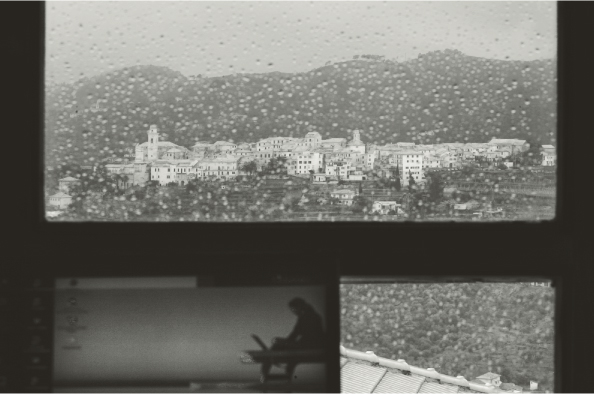
The Moment as Metaphor
The feelings of melancholy and sorrow are so deeply expressed in the facial expression and posture of the Indian woman in figure 10–2 that the photograph almost becomes a metaphor for these basic feelings. The light, however, does not convey a depressing mood, but instead it becomes somewhat transfigured. The sunlit cloth that she uses to cover her head gives her an almost Madonnalike appearance. An oval is the basic shape in the photo because it guides the eye around the composition. It is the nature of photography to freeze a fraction of an instant, and that’s why it is even more important to capture something on film or sensor that will unfold its effects over long periods and not lose its magic after it’s looked at for just a short time. A photograph endures when it reveals something so universally valid that the message of its image goes beyond documenting a specific moment. The photo was taken with an analog camera using a 105 mm telephoto lens.
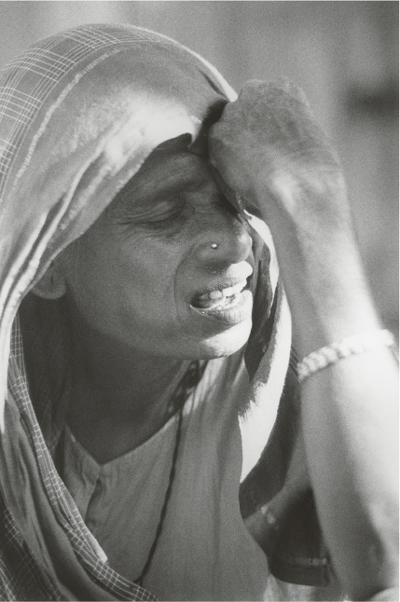
Youth by the Fence
The young man in figure 10–3 looks so intensively at New York’s Ground Zero that he has not noticed the photographer taking his photo, even in such close quarters. The young man’s facial expression reveals that he is feeling highly emotional when looking through the fence. The viewer recognizes this highly charged moment, a view to a past destroyed by disaster. However, what also makes the photo memorable is the shadow of the fence on the youth’s face and torso. This shadow creates an interesting graphic element that is important for a black and white photo; the photographer was brave enough to quickly move the camera to get the shot. The odds of capturing a successful shot were quite low. If the youth had been asked to look once again through the bars, he would certainly not have been as emotional. Why not take the risk? The worst-case scenario would have been for the subject to look away. Naturally, it is essential to assess the “victim” of this kind of snapshot because you may get a rather unfriendly reaction. Photographing a stranger from such a short distance (with the 50 mm lens) is, after all, an intrusion upon his privacy, but this intrusion is justified when the image represents the subject in a dignified way.
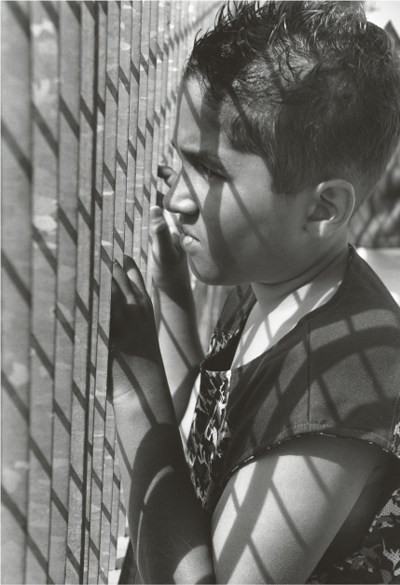
Madonna in the Parking Lot
In reality, the area shown in figure 10–4 is usually full of automobiles, campers, and tourists because the Madonna is located in an Irish pass nearby, and there is an outstanding view in both directions. Generally, the Madonna, which is fenced in by an attractive wall of natural stone, cannot be appreciated because of the numerous cars and human activity. However, when fog blocks the view, the atmosphere makes the Madonna and wall stand out. Only a No Parking sign indicates the hustle and bustle normally experienced in this place. Fog makes the world appear mysterious because it settles on things like a veil, thus forcing the viewer to play a game of hide and seek. The viewer wonders, “What can still be discovered behind this gray foggy wall?” The mysterious side of melancholy moods is expressed here.
The photo was taken digitally with a 29 mm focal length of a 17–40 mm Canon-L zoom lens.
Fog in Turkey
Fog settles like a delicate veil on the tall evergreen trees of the Katschkar Mountains in eastern Turkey (figure 10–5). Without the fog, such a forest landscape would have looked rather commonplace, but the fog adds an extra something to the image—a breath of fairy tale melancholy. It appears as if elves and fauns could live here, just as Arnold Boecklin often painted them in his landscape canvases. Fog creates a delicate interplay of the most varied shades of gray that were enhanced in the darkroom through careful dodging and burning in.
The photograph was taken with an analog Nikon F4 and a 200 mm telephoto lens and enlarged on grade 4 paper. The relatively large grain of Kodak’s Tri-X Pan is actually perceived as pleasant in such a foggy picture. However, you can obtain the same impression of film grain digitally.
Rainy Beach
A beach generally means sun, blue sky, sand, and an easy life, but in the next photo we see a leaden sky viewed through raindrops. Yet, the sky and raindrops are exactly the poetry in the image in figure 10–6. Thus, this image of a rainy beach in Lanzarote is a lot more interesting and moody than an image of a beach photographed for the hundredth time under intense sunlight, or even a sunset over the sea.
The photo was taken digitally with a 35 mm focal length and a Canon EOS 5D; sharpness was adjusted to the background. In spite of an aperture of f22, the raindrops in the foreground are not in focus, and this is exactly what makes this photo interesting. Even with professional zoom lenses, it is difficult to work with depth of field because they generally do not have depth of field control. The photo was converted to black and white using the Photoshop yellow filter preset. Contrast was increased by about 20 percent during the process.
These examples will hopefully motivate you to find inspiration in gloomy and melancholy moods that may lead to poetic images. After all, these sentimental tones belong to the varied range of existence.


